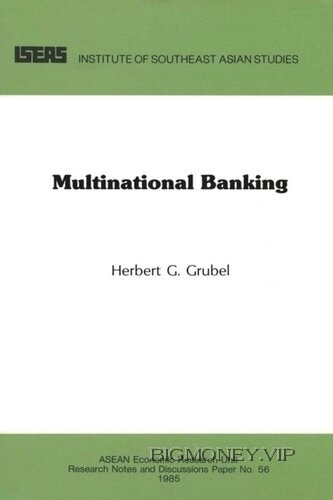
I
INTRODUCTION
Banks have always engaged in international business. They have
dealt in foreign exchange, extended credit in connection with
foreign trade, traded and held foreign assets, and provided tra-
vellers with letters of credit. All this and some other types of
business the banks historically have carried out from their domes-
tic locations. There was no need for a physical presence abroad.
Business that could not be carried out by mail or telecommuni-
cations was handled by correspondent banks abroad.
Some banks began to establish a physical presence abroad in
the late 19th and early 20th century. This move abroad mostly was
part of colonialism. Under the umbrella of the home country's
colonial government, banks from Britain opened branches in the
Indian subcontinent, Africa, Hong Kong, and Singapore; European
and North American banks moved into the Caribbean and Latin
America. These banks provided modern banking services to
economies which previously had no or only a relatively rudimentary
financial industry.
Multinational, also sometimes called transnational, banking
is of relatively recent origin. Its development coincided and
accelerated with the technological improvements and cost-reduc-
tions in international travel and communications in the post-war
period. This type of banking involves the physical presence of a
bank abroad.
The most prevalent and versatile legal form of this presence
is a branch, which uses the home-country bank's name and organi-
zation. It is usually an independent corporate entity with limi-
ted liabi1ities, whose shares are owned by the parent. Other
legal forms used in foreign physical presence are agencies and
representative offices, which have limited legal operational
authority but also limited liabilities. Subsidiaries are used if
ownership is shared with other firms or individuals, mostly resi-
dents of the country hosting the foreign bank. These subsidiaries
are mostly corporations with limited liability. In addition, of
course, banks have maintained networks of correspondent banks for
doing business in locations where they have no physical presence.
The theory of multinational banking explains why these banks
find it profitable to have a physical presence abroad. The theory
takes as given the most fundamental and important reason for any
foreign investment: it raises the risk-adjusted rate of return to
capital invested in the firm. The theory then develops explana-
tions of the sources of comparative advantage, which allows a bank
abroad to compete effectively with domestic banks. These domestic
banks would be expected to be more familiar with 1 oca 1 customs.
laws, governments, and business firms, and to have other cost
advantages. For example, their managers are locals who do not
have to be paid a premium salary to persuade them to work in a
foreign and sometimes relatively unpleasant environment. They do
not have to co-ordinate business across borders and spend extra
money on legal, translation, and communication services.
The theory of multinational banking addresses the same ques-
tion as the theory of multinational enterprise generally. It is
therefore no surprise to find that there is much overlap between
the two theories. Both rest on the proposition that modern busi-
ness generates certain assets for which there is no market except
inside the firm. To exploit the value of these assets, therefore,
the firm must operate abroad once it has expanded to the fullest
extent domestically. Through these foreign operations it in-
creases the return to its domestic capital above what it would
have been without this move abroad. Assets giving rise to this
motive are marketing and managerial know-how and information about
home-country multinational manufacturing firms and tourists.
Other important motives for multinational banking are the
avoidance or evasion of nation a 1 taxation by customers and the
escape from regulation and taxation by the banks themselves.
There are also certain technical scale economies and benefits from
the international diversification of business and portfolios.
In the following I discuss these motives for international
banking in greater detail and then use the ideas to speculate
about the welfare effects it has had. But before I turn to these
topics, I present some empirical data about the magnitude of
multinational banking.




